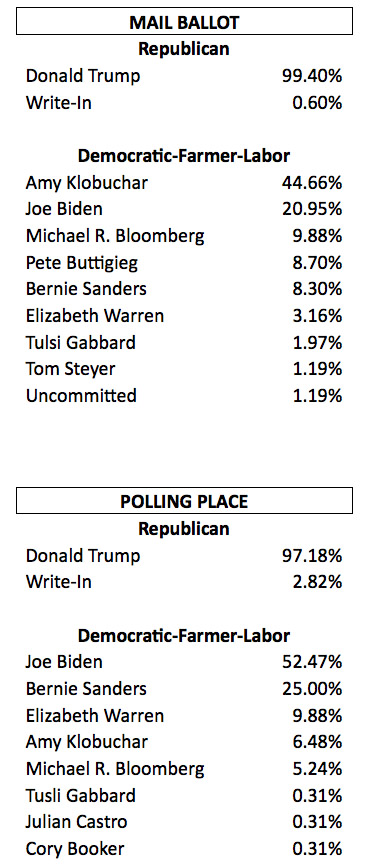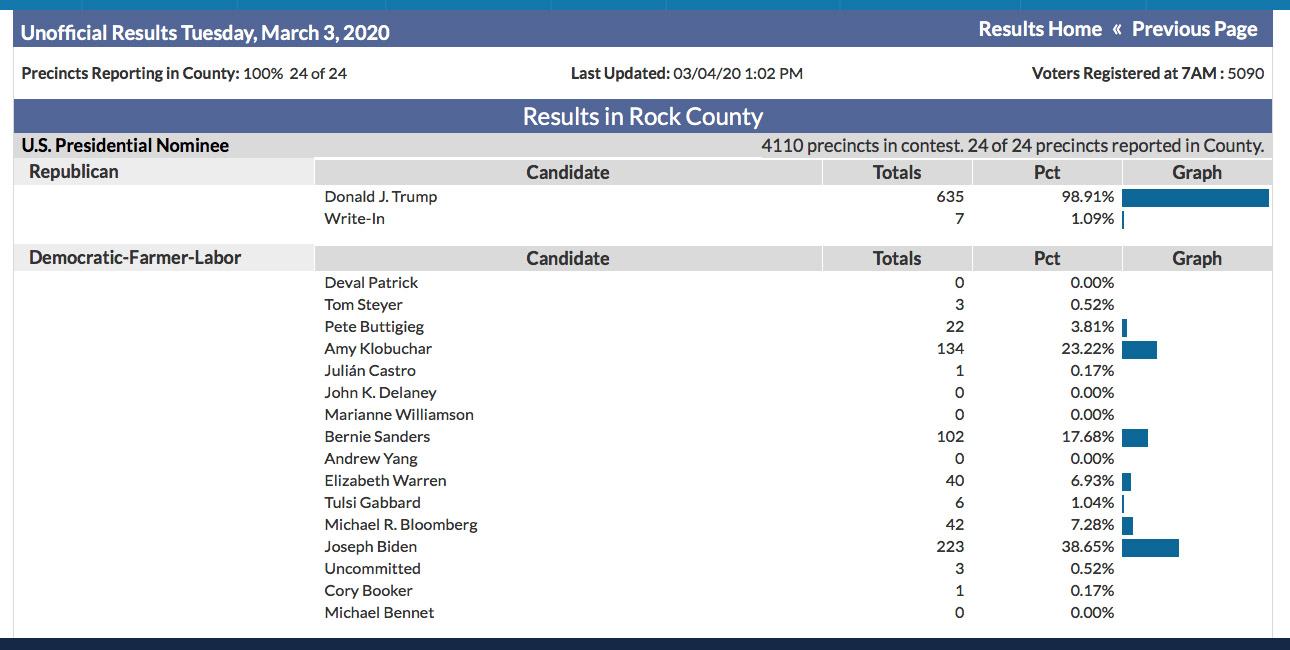 ,
, 
Minnesota Secretary of State Steve Simon applauded the 21-percent statewide voter turnout in the 2020 presidential nomination primary.
“We hadn’t held a binding primary like this since 1956, and so there was no real way to predict how voters would turn out,” he said, adding that 885,000 primary voters represent a 177-percent increase compared to 2016 caucuses.
“I am thrilled that Minnesotans turned out in these numbers for our new presidential primary. The purpose of this new election was to swing the doors wide open to more participation, and yesterday we saw just that.”
In Rock County more than 24 percent of registered voters participated last week, compared to 17.73 percent in the 2016 presidential primary election and 7.8 percent in the 2012 primary.
“It was hard to know what to expect as this was a new type of election I have never administered before,” said Rock County Auditor-Treasurer Ashley Kurtz.
“I think in the back of my mind, I was expecting it to be a similar turnout to a primary election, so the fact that it exceeded that was great.”
She said mail ballot voters led participation rates with 38.52 percent of potential mail voters returning ballots, and 14.98 percent of poll voters showing up March 3.
In a primary election, voters must choose which party to participate in. Of Rock County’s 1,207 primary ballots, 640 were GOP ballots (all but seven were for Trump), and 567 voters participated on the DFL side.
The secretary of state primary results showed Rock County DFL voters cast 223 ballots (38.65 percent) for Joe Biden, 134 for Amy Klobuchar (23.22 percent), 102 for Bernie Sanders (17.68 percent), 42 for Michael Bloomberg (7.28) and 40 for Elizabeth Warren (6.93).
In Rock County Kurtz broke down the 690 mail (and absentee) ballots and 517 polling place ballots to show 44.66 percent of mail voters chose Klobuchar, who dropped out of the race one day before the March 3 Minnesota primary and threw her support toward Biden who garnered 20.95 percent of the DFL mail ballots.
Voters who showed up at polling place in Rock County (a day after Klobuchar dropped out) subsequently supported Biden 52.47 percent and Sanders 25 percent.
While early voting and mail ballot voting is proven to boost voter turnout, election officials recognize that candidates do drop out, and voters can’t change their ballots once the deadline passes seven days ahead of Election Day.
“That is the unfortunate part of the presidential nomination primary,” Kurtz said. “In other elections, we don’t have to worry so much about candidates dropping out, but that was definitely a factor in Tuesday’s election,”
Kurtz said a few voters called her office wanting to change their ballots, but it was past the “claw back” period.
“I think that is a risk that people take by voting early in the presidential nomination primary and maybe in future elections like this, they will choose to come vote on Election Day if they can make it. We don’t normally see any issues like this with the state primary or general elections.”
The dropped candidates raised the issue of ranked choice voting, which some advocate as a sure way to elect candidates by majority.
However, Kurtz said it would create confusion.
“A change like that is huge and would require a lot of voter education,” she said.
“For example, this election, we had more rejected mail ballots than we have ever seen. Mail voters were required to check a box on the outside of their signature envelope that indicated which ballot they voted and placed in the ballot envelope. If they didn’t mark that envelope, we couldn’t accept their ballot.”
She said some mail voters marked the signature envelop but then enclosed a ballot that contained votes for each party.
“In this case, both ballots were spoiled and their votes didn’t count,” Kurtz said.
Secretary of State Simon said he was pleased with the state’s smooth transition from caucus-style nominations to the presidential nomination primary voting.
“I’m heartened by this display of our state’s civic engagement,” he said. “I, my office, and local officials around the state now look ahead to the August primary and November general election, and look forward to providing the same secure and reliable service to the people of Minnesota.”


